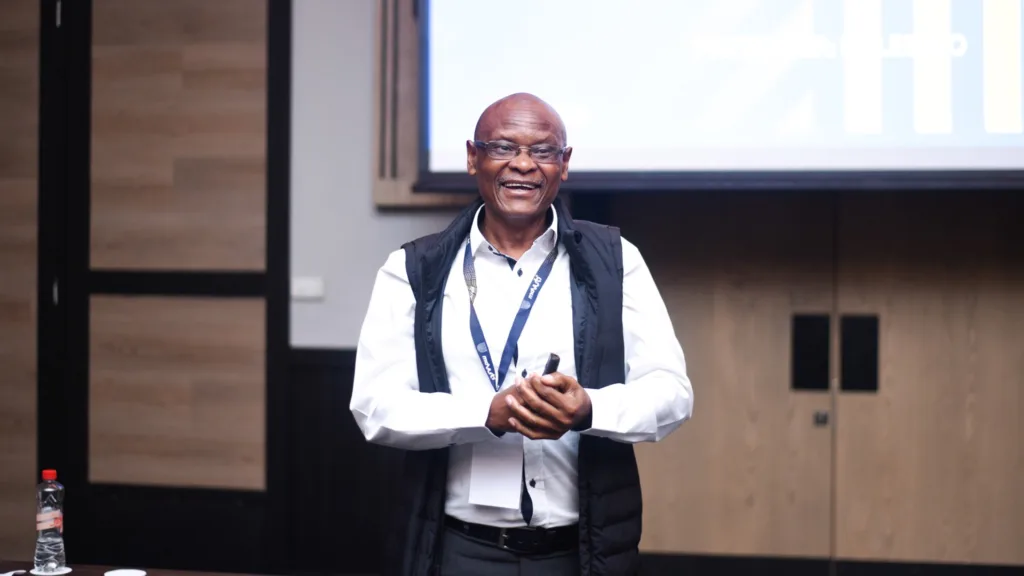“A mathematical exploration of how reactive waste materials produce hidden heat and carbon dioxide, revealing overlooked contributors to climate change”
25 November 2025 | Story by: Tshepiso Kaibe | Picture: Keitumetse Mokgope
3 minutes read time.

At the 1st International Conference on Innovative Pathways for Sustainable Futures (IPSF) 2025, held from 20 to 21 November 2025, Associate Professor Solly Lebelo, an Associate Professor of Applied Mathematics in the Applied Physical Sciences Department within the Faculty of Applied and Computer Sciences at Vaal University of Technology, delivered one of the event’s most insightful presentations. Representing his team of collaborators, he explored an often-overlooked contributor to climate change: the heat and carbon dioxide released by exothermic chemical reactions in reactive waste materials.
Opening his presentation, Professor Lebelo reminded delegates that climate change cannot be understood without acknowledging the role of heat produced through chemical processes. He explained that global warming intensifies through the combustion of materials present in everyday environments, including municipal dumping sites, industrial waste, and coal stockpiles. “Climate change is caused by global warming, and global warming is linked to the combustion of materials,” he said, framing the foundation of his talk.
He challenged the audience to reconsider the waste they see at landfill sites. What may appear to be ordinary rubbish is often a complex mixture of plastics, compost, hay and other substances rich in carbon and hydrocarbons. These materials, when left in large stockpiles, can undergo processes that directly contribute to greenhouse gas emissions. “You may think that this is just rubbish, but it detrimentally affects the environment,” he noted. His visual examples, such as smoking waste heaps and coal piles emitting vapour with no visible ignition source, illustrated how common these reactions are.
Professor Lebelo explained that as oxygen becomes trapped within these stockpiles, it reacts with the carbon present in the materials. He described this as a spontaneous exothermic reaction that produces carbon dioxide, water vapour and heat. “Carbon combines with oxygen and the reaction produces products that include heat and carbon dioxide,” he said. These products become hazardous when the heat cannot escape the system. Over time, the temperature within the stockpile rises until it surpasses a critical level. Once this happens, spontaneous combustion occurs, releasing even more heat and carbon dioxide into the surrounding environment.
He stressed that this process is not limited to industrial settings. Coal mine waste, compost heaps, agricultural materials, and general household rubbish can all undergo the same reaction. “The more carbon dioxide is produced, the more it increases the temperature of
the environment, which affects the climate,” he explained, emphasising the broader implications for global warming.
A key focus of his presentation was the role of mathematics in understanding and predicting these reactions. Drawing on the Navier–Stokes equations and models of energy and mass transfer, he demonstrated how mathematical tools can be used to study heat accumulation and gas movement within reactive materials. He highlighted the importance of steady-state expressions, noting that they enable researchers to work with equations that are independent of time. “Once the partial differential equation is independent of time, it becomes an ordinary differential equation,” he explained, showing how complex processes can be simplified for analysis.
Through this mathematical lens, Professor Lebelo and his collaborators aim to quantify the conditions that lead to spontaneous combustion and to understand how these reactions contribute to climate change. This approach, he argued, positions mathematics as a crucial discipline for addressing environmental challenges. It enables researchers, policymakers, and industries to predict risks, improve waste management practices, and mitigate the unintended heat emissions that worsen global warming.
Professor Lebelo’s presentation highlighted that climate change is not driven only by visible forms of pollution. Hidden within waste piles and industrial stockpiles are slow, reactive processes that generate heat and carbon dioxide without flames or warning signs. Through mathematical modelling, these silent contributors can be brought to light, offering new pathways for environmental protection and sustainable futures.
